Using the Groundwater Cooling System and Phenolic Aldehyde Isolation Layer on Building Walls to Evaluation of Heat Effect
Abstract
:1. Introduction
2. Research Methodology
- Assessing the thermal environmental impact of buildings with concrete walls under full sunlight.
- Evaluating the impact of integrating concrete walls with a groundwater cooling system.
- Analyzing the effect of adding a phenolic insulation layer to concrete walls.
- Assessing the combined benefits of a groundwater cooling system and a phenolic aldehyde insulation layer.
2.1. Energy Equation for Multiphysics CFD Modeling
2.2. Operative Temperature in Thermal Climate Analysis
3. Results and Discussion
3.1. Thermal Environmental Impact of Buildings with Concrete Walls in Full Sunlight
3.2. Implementation of an Underground Water Cooling System in the Walls
3.3. Wall with Phenolic Aldehyde Resin Layer
3.4. Wall with Phenolic Aldehyde Resin Layer and Groundwater Cooling System
4. Conclusions
- The effect of heat on the building wall and indoor space.
- The impact of the groundwater cooling system on the building wall’s thermal environment.
- The influence of the phenolic aldehyde insulation layer on wall heat transfer.
- A comprehensive analysis of the combined effects of groundwater cooling and phenolic aldehyde thermal insulation.
- Effectiveness of Insulation Methods: Both the phenolic aldehyde insulation layer and the groundwater cooling system demonstrate significant thermal insulation effects, with the groundwater cooling system proving to be the most effective.
- Heat Transfer Reduction: The phenolic aldehyde insulation layer effectively reduces heat transfer through the wall into the room. Evaluations show that the temperature difference between the inner and outer walls is approximately 8 °C. The groundwater cooling system further lowers the inner wall temperature compared to other conditions and also reduces the outer wall temperature more effectively.
- Heat Source Analysis: Simulations indicate that the primary heat source at noon is the building’s roof. While the phenolic aldehyde insulation layer can block external heat from entering the room, it cannot dissipate the heat, leading to heat accumulation indoors, as shown in thermal analyses from 12:00 p.m. to 2:00 p.m. This issue does not occur with the groundwater cooling system.
- Groundwater Temperature Analysis: The maximum inlet–outlet temperature difference for the groundwater system occurs between 8:00 a.m. and 10:00 a.m. for the east wall, and between 2:00 p.m. and 4:00 p.m. for the west wall. The water flow effectively carries away heat from the walls and surrounding areas, causing the water temperature to rise gradually and contributing to space cooling.
- Combined Insulation Approach: By combining the groundwater cooling system with the phenolic aldehyde insulation layer, heat is removed externally while the internal phenolic aldehyde thermal barrier prevents heat transfer through the wall. This dual approach maintains a stable indoor temperature, significantly reducing the air conditioning load and ensuring a comfortable indoor environment.
- Optimal Heat Insulation Strategy: The combination of the phenolic aldehyde insulation layer and the groundwater cooling system offers effective heat insulation and cooling. The phenolic aldehyde insulation layer acts as a secondary barrier, preventing heat from penetrating through the cooling pipe system into the room. This allows for a reduction in groundwater flow velocity, decreased frequency of water circulation, and lower energy consumption by the driving motor, thereby maintaining groundwater temperature near 19 °C and optimizing the system’s operational efficiency.
- Considerations for System Efficiency: While the groundwater system effectively dissipates heat from the walls, careful attention must be paid to the heat exchange within the underground aquifer. Faster groundwater flow rates improve the system’s cooling efficiency. However, if the wall pipeline spacing is too wide, heat can easily transfer into the interior. Conversely, a higher pipeline density increases costs and adds weight to the walls, potentially impacting the building’s structural integrity. Using insulation materials in conjunction with the cooling system is optimal, but these materials have a finite lifespan and must be replaced upon expiration to maintain their functionality.
Author Contributions
Funding
Institutional Review Board Statement
Informed Consent Statement
Data Availability Statement
Conflicts of Interest
References
- Taniguchi, M.; Uemura, T. Effects of Urbanization and Groundwater Flow on the Subsurface Temperature in Osaka, Japan. Phys. Earth Planet. Inter. 2005, 152, 305–313. [Google Scholar] [CrossRef]
- Arif, H.; Tolga, M. A Study on Modeling and Performance Assessment of a Heat Pump System for Utilizing Low Temperature Geothermal Resources in Buildings. Build. Environ. 2007, 42, 3747–3756. [Google Scholar]
- Hadi, F.A.; Hikari, F.; Hiroyuki, K. Cooling Tests, Numerical Modeling, and Economic Analysis of Semi-Open Loop Ground Source Heat Pump System. Geothermics 2018, 71, 34–45. [Google Scholar]
- Rowe, J.M.; Paul, J.D. Cooling the London Underground: Evaluating the use of groundwater and subterranean river water. Sustain. Cities Soc. 2022, 76, 103531. [Google Scholar] [CrossRef]
- Huang, Z.K.; Cheng, Y.; Zhang, D.; Yan, D. Seismic fragility and resilience assessment of shallowly buried large-section underground civil defense structure in soft soils: Framework and application. Tunn. Undergr. Space Technol. 2024, 146, 105640. [Google Scholar] [CrossRef]
- Yang, J.; Song, W.; Wang, Z.; Dong, J.; Zhang, H. Direct/indirect optimal use of shallow geothermal energy in floor radiant cooling system coupled with air-handling system. J. Build. Eng. 2024, 89, 109206. [Google Scholar] [CrossRef]
- Grant, F. Characterizing Uncertainty in Groundwater-Source Heating and Cooling Projects in Manitoba, Canada. Energy 2012, 37, 201–206. [Google Scholar]
- Antonio, G.; Matteo, C. Thermal Short Circuit on Groundwater Heat Pump. Appl. Therm. Eng. 2013, 57, 107–115. [Google Scholar]
- Ampofo, F.; Maidment, G.G.; Missenden, J.F. Application of Groundwater Cooling Scheme for London Underground Network. Int. J. Refrig. 2011, 34, 2042–2049. [Google Scholar] [CrossRef]
- Issam, M.; Hind, D.R. Enhancement of Evaporative Cooling System in a Greenhouse Using Geothermal Energy. Renew. Energy 2017, 111, 321–331. [Google Scholar]
- Bricker, S.H.; Banks, V.J.; Galik, G.; Tapete, D.; Jones, R. Accounting for Groundwater in Future City Visions. Land Use Policy 2017, 69, 618–630. [Google Scholar] [CrossRef]
- Gerhard, R.; Hans, K. 3D Modeling of Groundwater Heat Transport in the Shallow Westliches Leibnitzer Feld Aquifer, Austria. J. Hydrol. 2018, 557, 668–678. [Google Scholar]
- Luo, J.; Xue, W.; Shao, H. Thermo-economic comparison of coal-fired boiler-based and groundwater-heat-pump based heating and cooling solution—A case study on a greenhouse in Hubei, China. Energy Build. 2020, 223, 110214. [Google Scholar] [CrossRef]
- Ihoume, I.; Tadili, R.; Arbaoui, N.; Bazgaou, A.; Idrissi, A.; Benchrifa, M.; Fatnassi, H. Performance study of a sustainable solar heating system based on a copper coil water to air heat exchanger for greenhouse heating. Sol. Energy 2022, 232, 128–138. [Google Scholar] [CrossRef]
- Zhou, M.; Cai, F.; Arai, K. Cyclic use of groundwater: An innovative way to improve performance of a groundwater source heat pump system during a cooling period. J. Build. Eng. 2022, 51, 104325. [Google Scholar] [CrossRef]
- Boughanmi, H.; Khaldi, N.; Lazaar, M.; Guizani, A. Enhancing nocturnal microclimate in Tunisian greenhouses: Experimental study on integrating an innovative conic helicoidally heat exchanger with a geothermal heat pump system. Geothermics 2024, 123, 103127. [Google Scholar] [CrossRef]
- Cavazzini, G.; Zanetti, G.; Benato, A. Analysis of a domestic air heat pump integrated with an air-geothermal heat exchanger in real operating conditions: The case study of a single-family building. Energy Build. 2024, 315, 114302. [Google Scholar] [CrossRef]
- Oldmeadow, E.; Marinova, D.; Birks, D.; Whittall, S.; Brown, S. Low Temperature Geothermal Applications as Enablers of Sustainable Development: Practical Case Studies from Australia and UK. Water Resour. Manag. 2011, 25, 3053–3071. [Google Scholar] [CrossRef]
- Zyoud, S.; Rühaak, W.; Sass, I. Dynamic Numerical Modeling of the Usage of Groundwater for Cooling in North East Jordan–A Geothermal Case Study. Renew. Energy 2014, 62, 63–72. [Google Scholar] [CrossRef]
- Petr, B.; Anatolijs, S.; Ksenia, S. Utilization Potential of Low Temperature Hydronic Space Heating Systems: A Comparative Review. Build. Environ. 2017, 112, 88–98. [Google Scholar]
- Wang, H.; Xu, Y.; Yuan, L.; Sun, Y.; Cai, Y. Analysis of geothermal heat recovery from abandoned coal mine water for clean heating and cooling: A case from Shandong, China. Renew. Energy 2024, 228, 120659. [Google Scholar] [CrossRef]
- Daniel, R.; Mikael, R.; Lars, W. CFD Modelling of Radiators in Buildings with User-Defined Wall Functions. Appl. Therm. Eng. 2016, 94, 266–273. [Google Scholar]
- Mahmoud, M.; Abdelkareem, M.A.; Olabi, A.G. Chapter 2.6—Modeling and simulation of geothermal energy systems. Renew. Energy 2024, 2, 197–211. [Google Scholar]

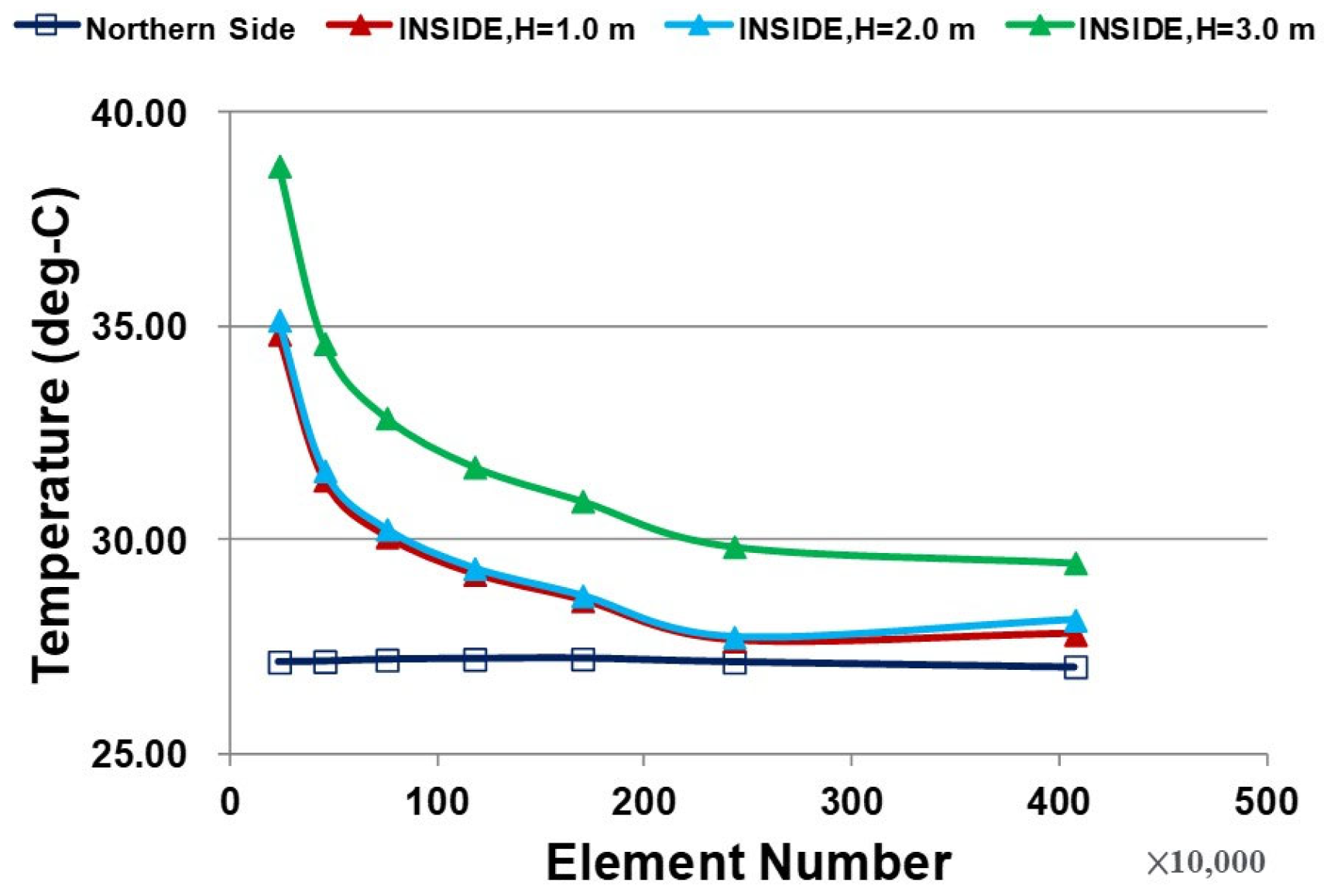


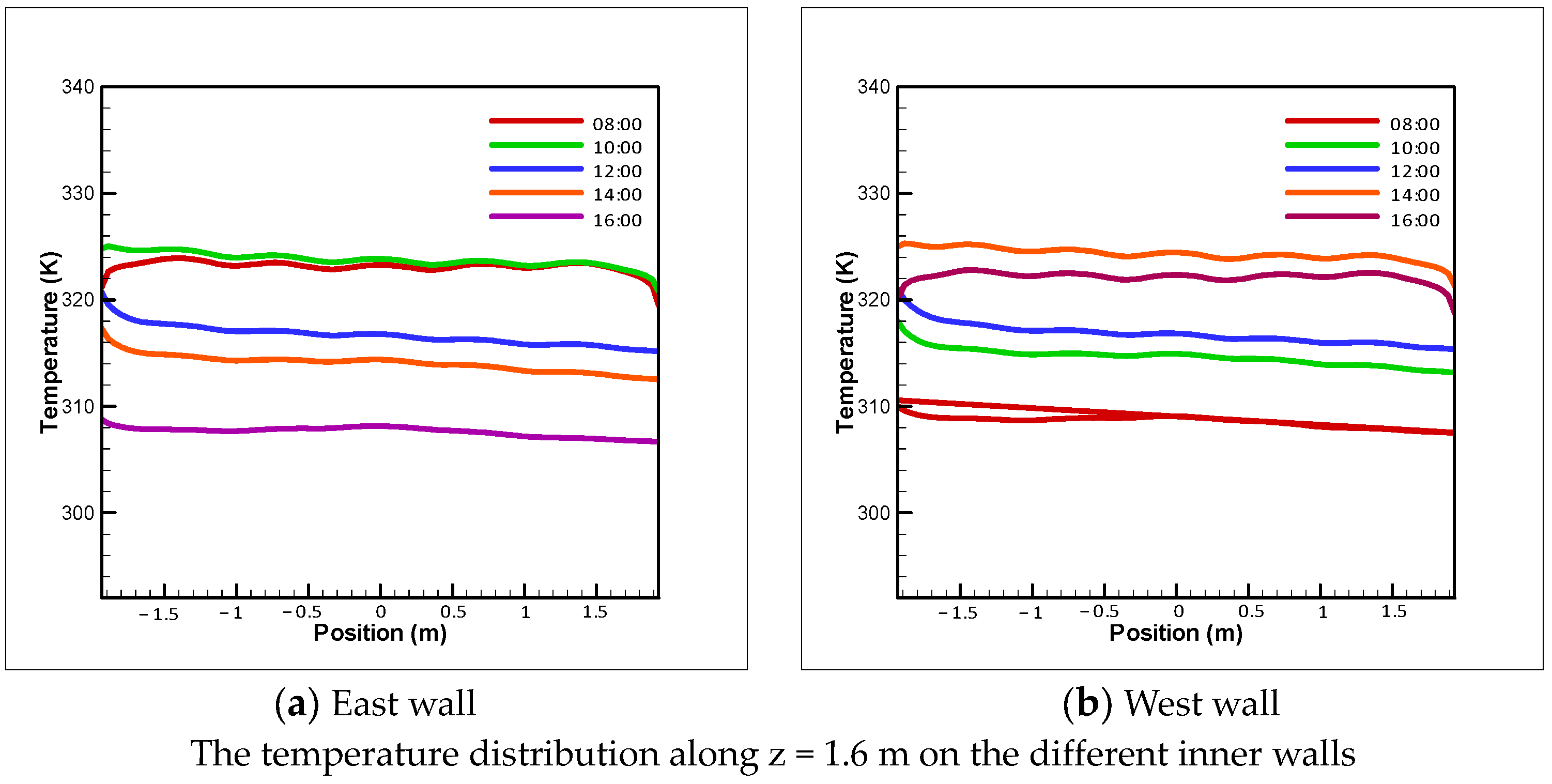

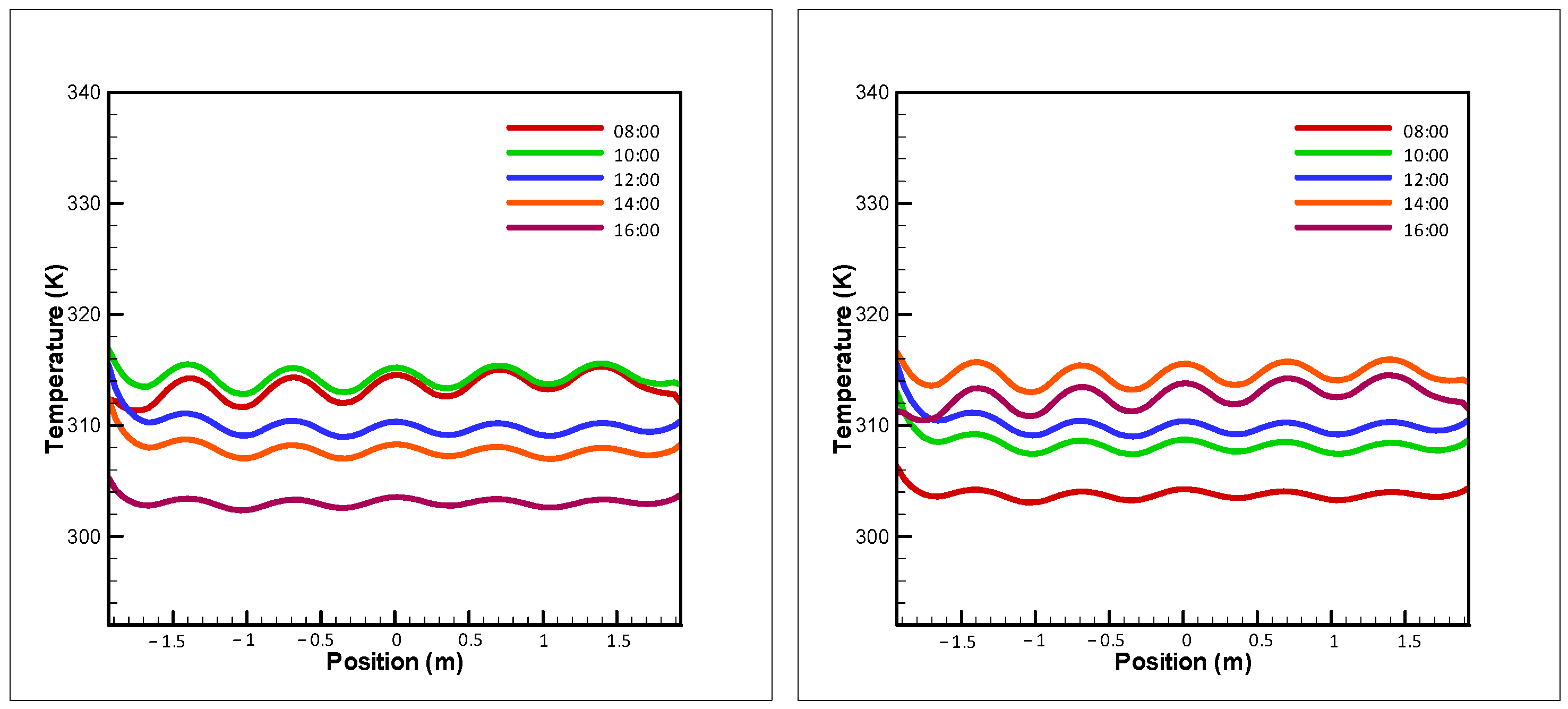

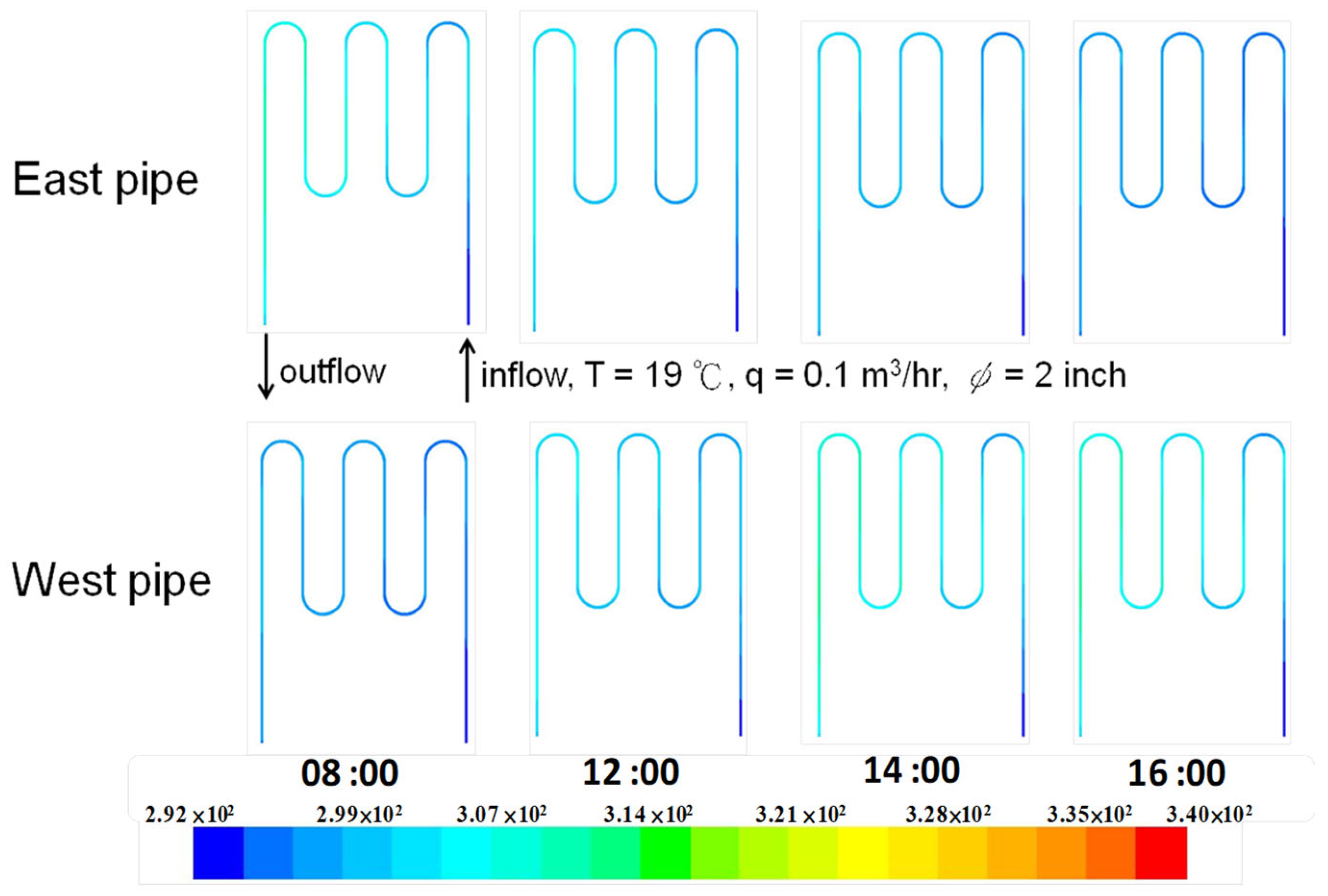
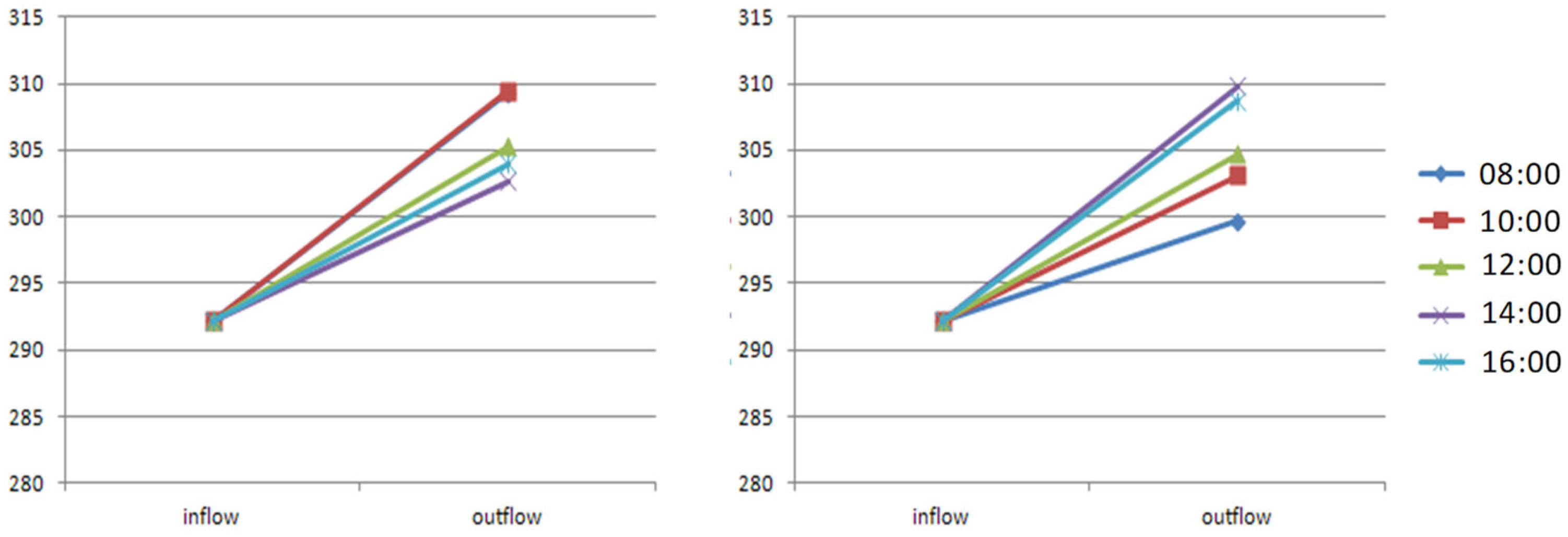
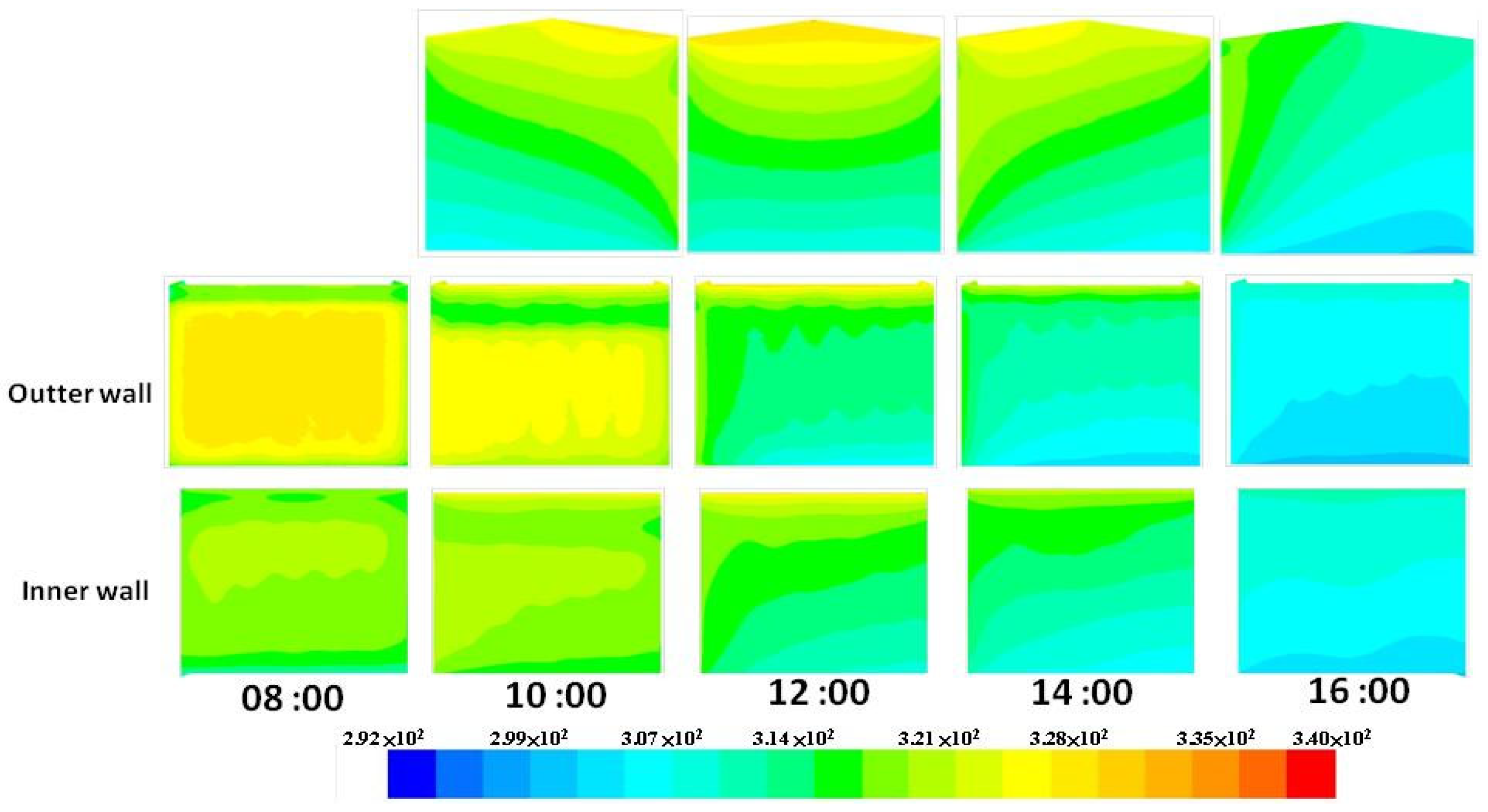


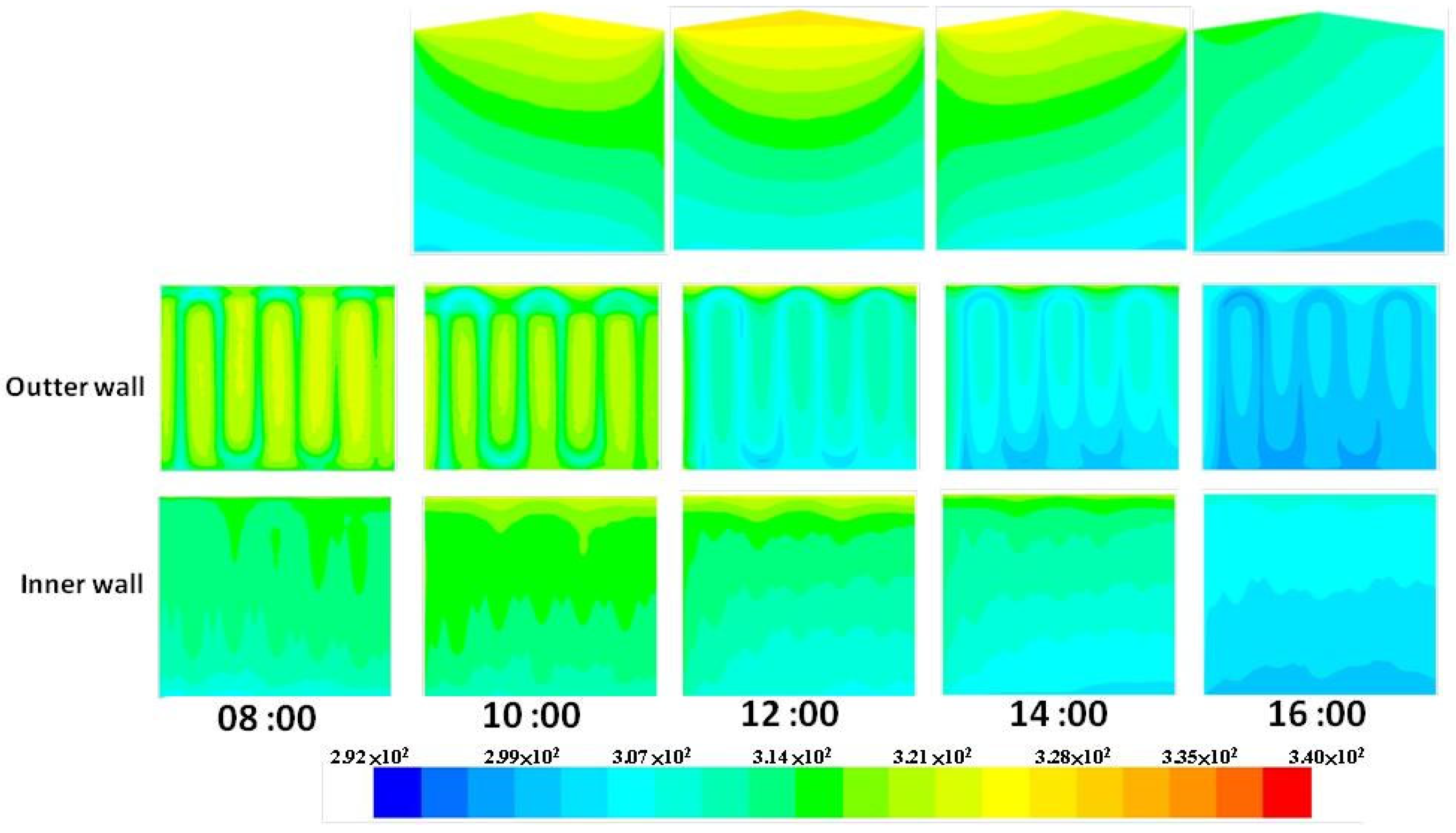
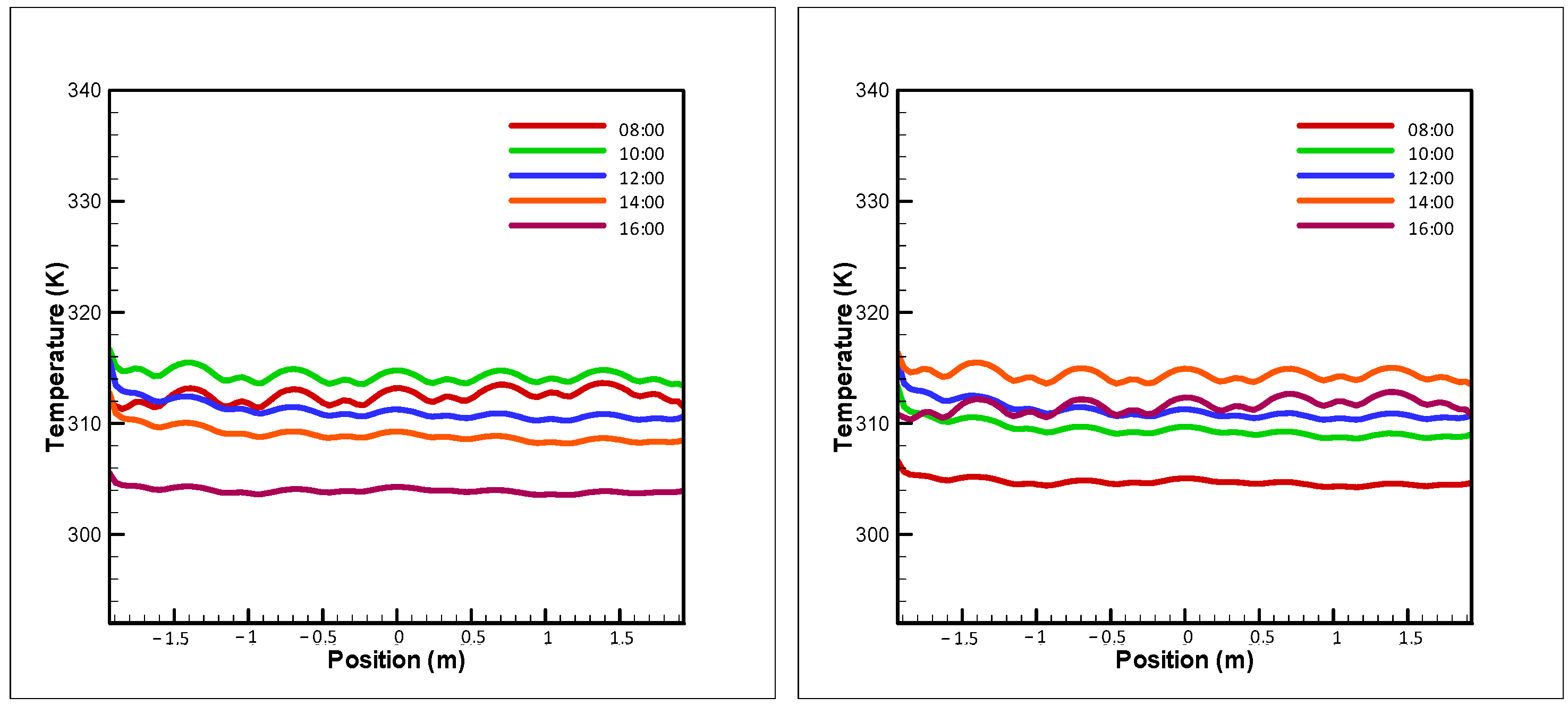

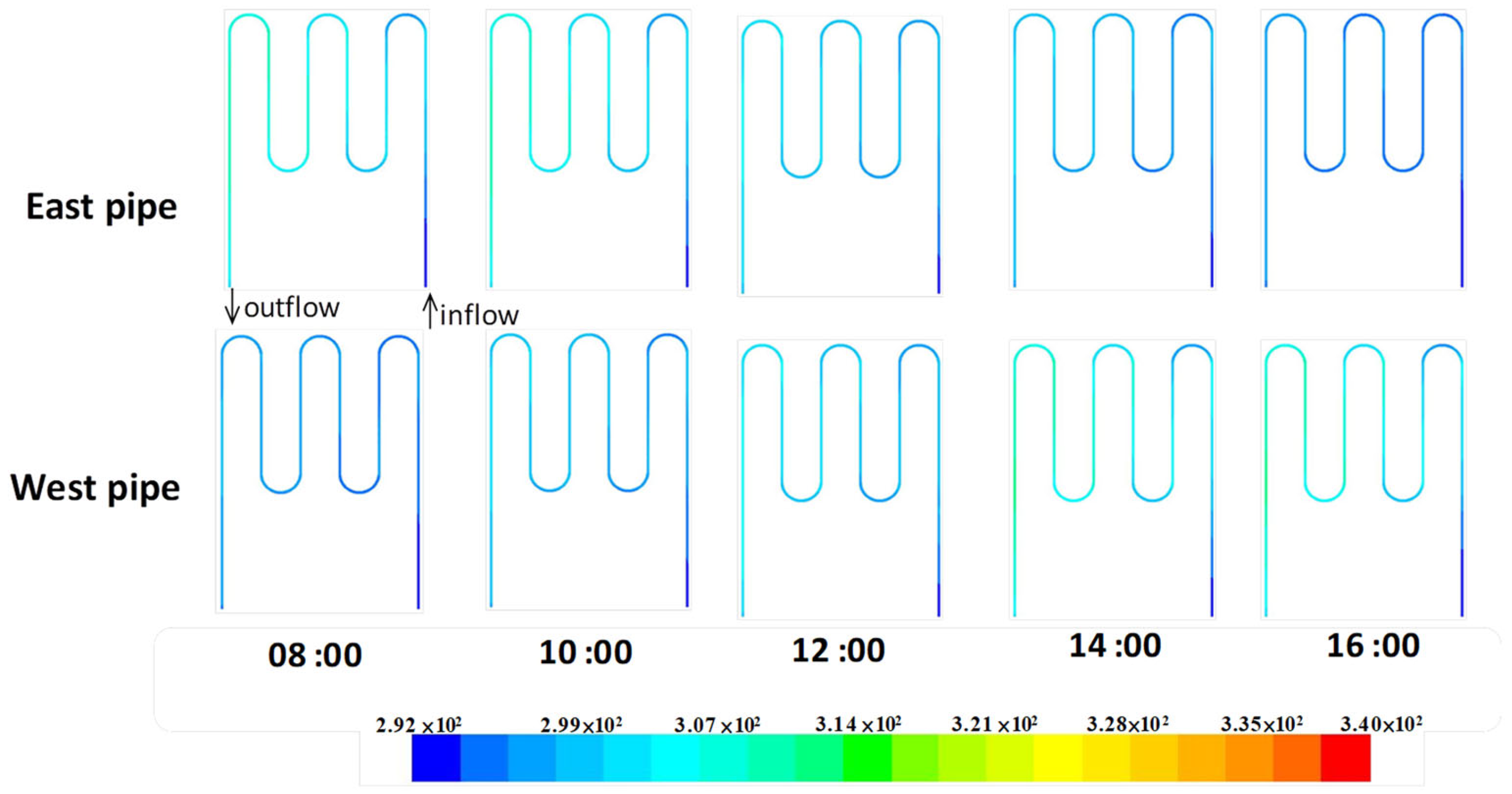
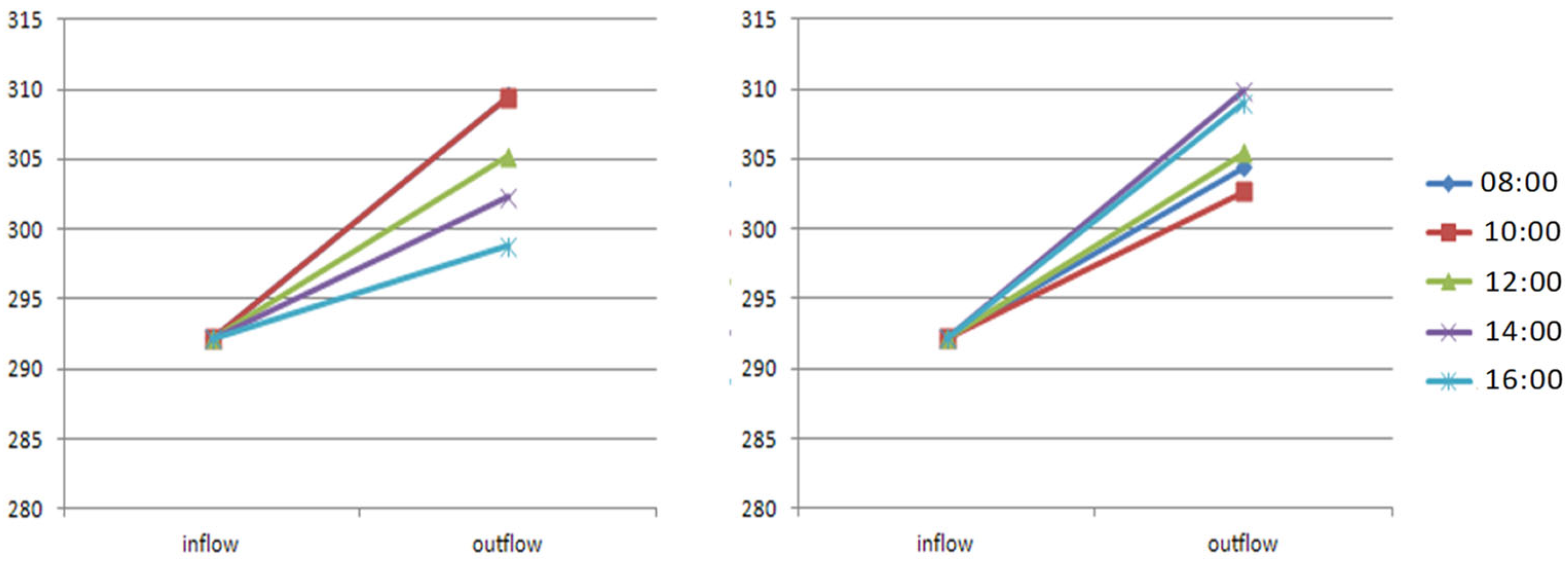
| Density (kg/m3) | Cp (J/kg·k) | Thermail Conductivity (w/mk) |
| Phenolic Aldehyde Resin | 1.071 | 840 | 0.035 |
| Concrete | 2243 | 837.4 | 1.890 |
| |||
| Water | 998.2 | 4182 | 0.6 |
| Air | 1.225 | 1006.43 | 0.0242 |
| 4 m × 4 m × 3.2 m | ||
| 19 °C | ||
| 0.1 m3/h | ||
Disclaimer/Publisher’s Note: The statements, opinions and data contained in all publications are solely those of the individual author(s) and contributor(s) and not of MDPI and/or the editor(s). MDPI and/or the editor(s) disclaim responsibility for any injury to people or property resulting from any ideas, methods, instructions or products referred to in the content. |
© 2024 by the authors. Licensee MDPI, Basel, Switzerland. This article is an open access article distributed under the terms and conditions of the Creative Commons Attribution (CC BY) license (https://creativecommons.org/licenses/by/4.0/).
Share and Cite
Chen, T.-Y.; Sung, W.-P. Using the Groundwater Cooling System and Phenolic Aldehyde Isolation Layer on Building Walls to Evaluation of Heat Effect. Buildings 2024, 14, 2848. https://doi.org/10.3390/buildings14092848
Chen T-Y, Sung W-P. Using the Groundwater Cooling System and Phenolic Aldehyde Isolation Layer on Building Walls to Evaluation of Heat Effect. Buildings. 2024; 14(9):2848. https://doi.org/10.3390/buildings14092848
Chicago/Turabian StyleChen, Ting-Yu, and Wen-Pei Sung. 2024. "Using the Groundwater Cooling System and Phenolic Aldehyde Isolation Layer on Building Walls to Evaluation of Heat Effect" Buildings 14, no. 9: 2848. https://doi.org/10.3390/buildings14092848






